2023 NISSAN PATHFINDER child lock
[x] Cancel search: child lockPage 17 of 665

1. Rear window wiper and washer switch(P. 2-81)
2. Lif tgate release (P. 3-29) 3. Rearview camera (P. 4-3, 4-10)
4. Towing (P. 10-20)
5. Rear sonar sensors (P. 5-183)
6. Replacing bulbs (P. 8-26)7. Fuel-filler door (P. 3-31)
Fuel recommendation (P. 10-4)
8. Child safety rear door lock (P. 3-7)
Refer to the page number indicated in
parentheses for operating details.
LII2669
EXTERIOR REAR
0-4Illustrated table of contents
Page 27 of 665
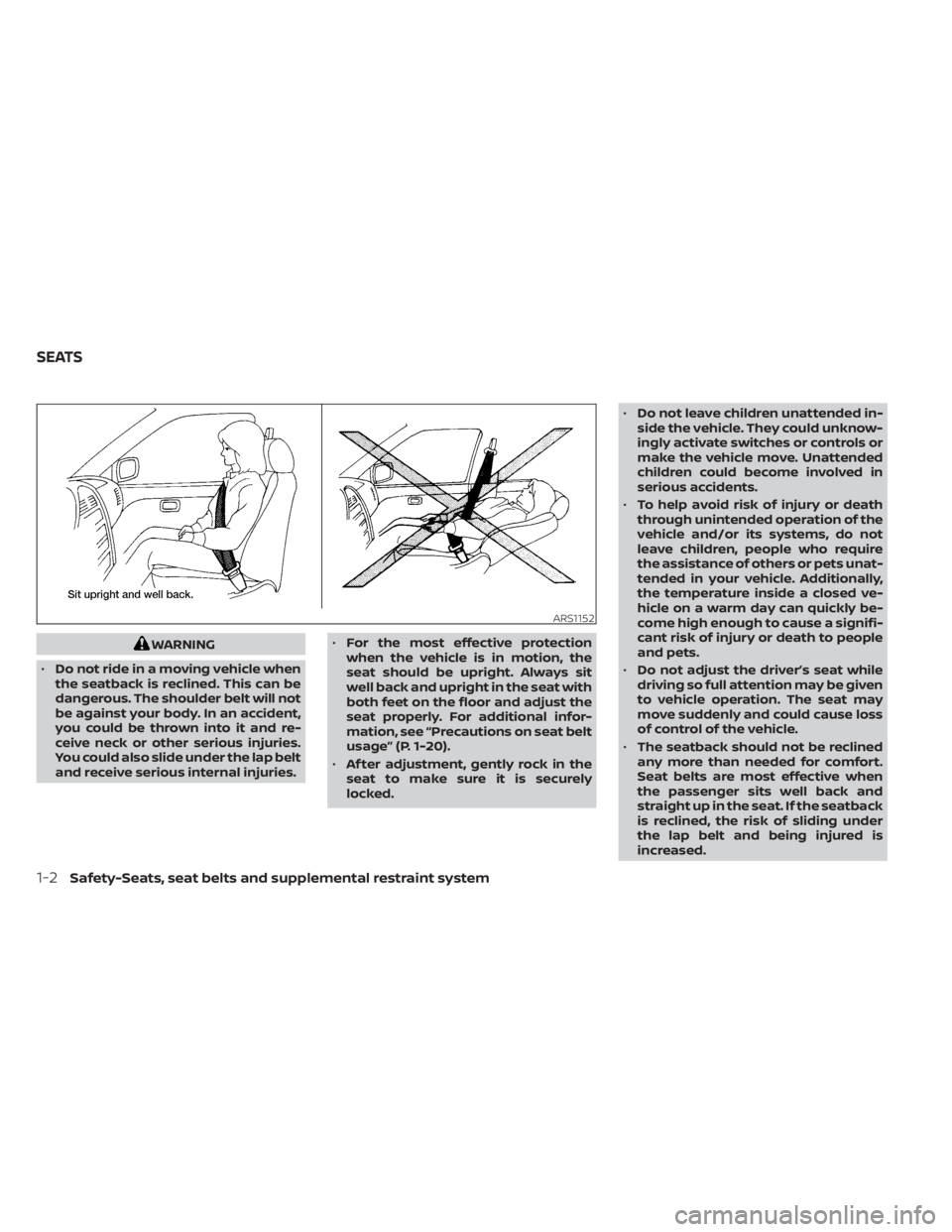
WARNING
• Do not ride in a moving vehicle when
the seatback is reclined. This can be
dangerous. The shoulder belt will not
be against your body. In an accident,
you could be thrown into it and re-
ceive neck or other serious injuries.
You could also slide under the lap belt
and receive serious internal injuries. •
For the most effective protection
when the vehicle is in motion, the
seat should be upright. Always sit
well back and upright in the seat with
both feet on the floor and adjust the
seat properly. For additional infor-
mation, see “Precautions on seat belt
usage” (P. 1-20).
• Af ter adjustment, gently rock in the
seat to make sure it is securely
locked. •
Do not leave children unattended in-
side the vehicle. They could unknow-
ingly activate switches or controls or
make the vehicle move. Unattended
children could become involved in
serious accidents.
• To help avoid risk of injury or death
through unintended operation of the
vehicle and/or its systems, do not
leave children, people who require
the assistance of others or pets unat-
tended in your vehicle. Additionally,
the temperature inside a closed ve-
hicle on a warm day can quickly be-
come high enough to cause a signifi-
cant risk of injury or death to people
and pets.
• Do not adjust the driver’s seat while
driving so full attention may be given
to vehicle operation. The seat may
move suddenly and could cause loss
of control of the vehicle.
• The seatback should not be reclined
any more than needed for comfort.
Seat belts are most effective when
the passenger sits well back and
straight up in the seat. If the seatback
is reclined, the risk of sliding under
the lap belt and being injured is
increased.
ARS1152
SEATS
1-2Safety-Seats, seat belts and supplemental restraint system
Page 32 of 665
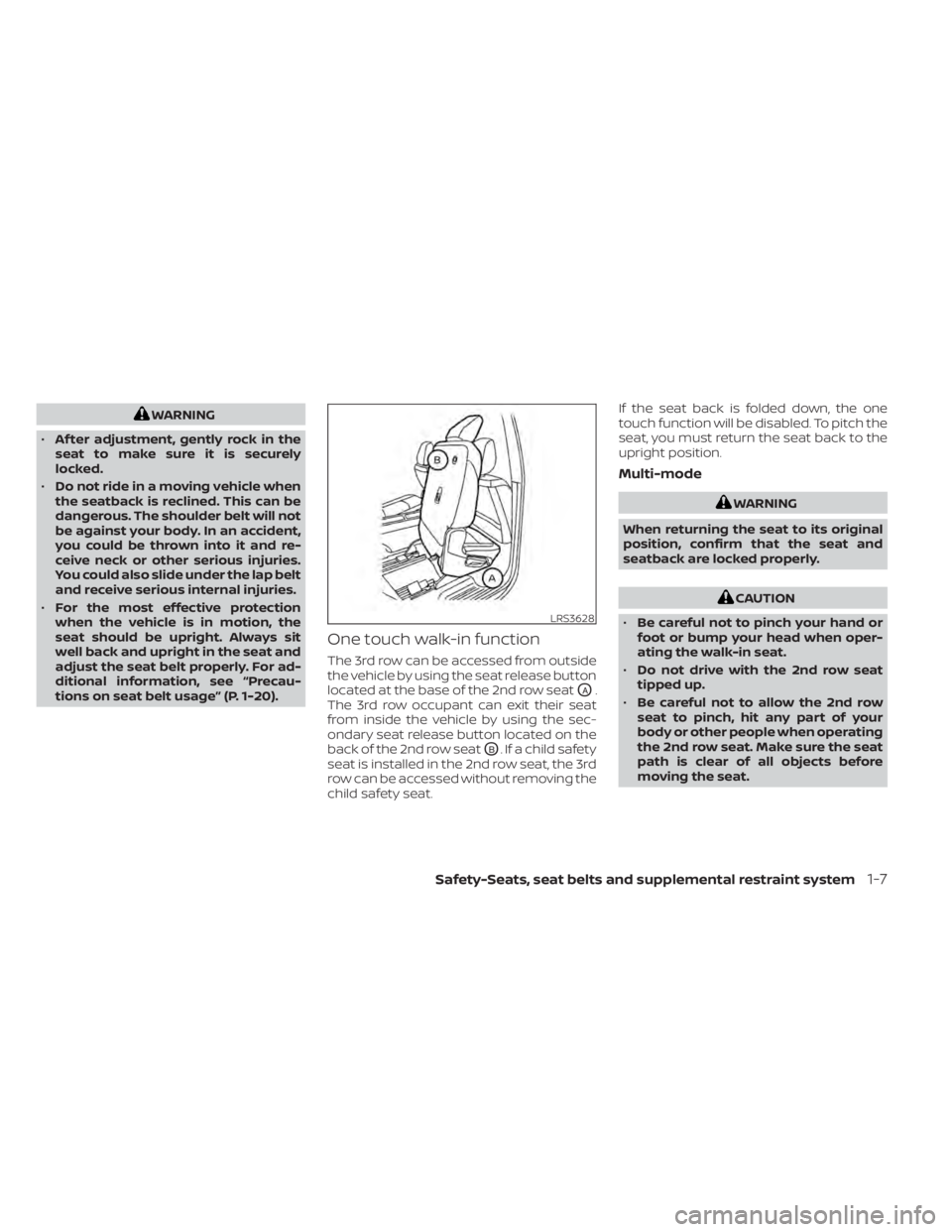
WARNING
• Af ter adjustment, gently rock in the
seat to make sure it is securely
locked.
• Do not ride in a moving vehicle when
the seatback is reclined. This can be
dangerous. The shoulder belt will not
be against your body. In an accident,
you could be thrown into it and re-
ceive neck or other serious injuries.
You could also slide under the lap belt
and receive serious internal injuries.
• For the most effective protection
when the vehicle is in motion, the
seat should be upright. Always sit
well back and upright in the seat and
adjust the seat belt properly. For ad-
ditional information, see “Precau-
tions on seat belt usage” (P. 1-20).
One touch walk-in function
The 3rd row can be accessed from outside
the vehicle by using the seat release button
located at the base of the 2nd row seat
OA.
The 3rd row occupant can exit their seat
from inside the vehicle by using the sec-
ondary seat release button located on the
back of the 2nd row seat
OB. If a child safety
seat is installed in the 2nd row seat, the 3rd
row can be accessed without removing the
child safety seat. If the seat back is folded down, the one
touch function will be disabled. To pitch the
seat, you must return the seat back to the
upright position.
Multi-mode
WARNING
When returning the seat to its original
position, confirm that the seat and
seatback are locked properly.
CAUTION
• Be careful not to pinch your hand or
foot or bump your head when oper-
ating the walk-in seat.
• Do not drive with the 2nd row seat
tipped up.
• Be careful not to allow the 2nd row
seat to pinch, hit any part of your
body or other people when operating
the 2nd row seat. Make sure the seat
path is clear of all objects before
moving the seat.
LRS3628
Safety-Seats, seat belts and supplemental restraint system1-7
Page 33 of 665
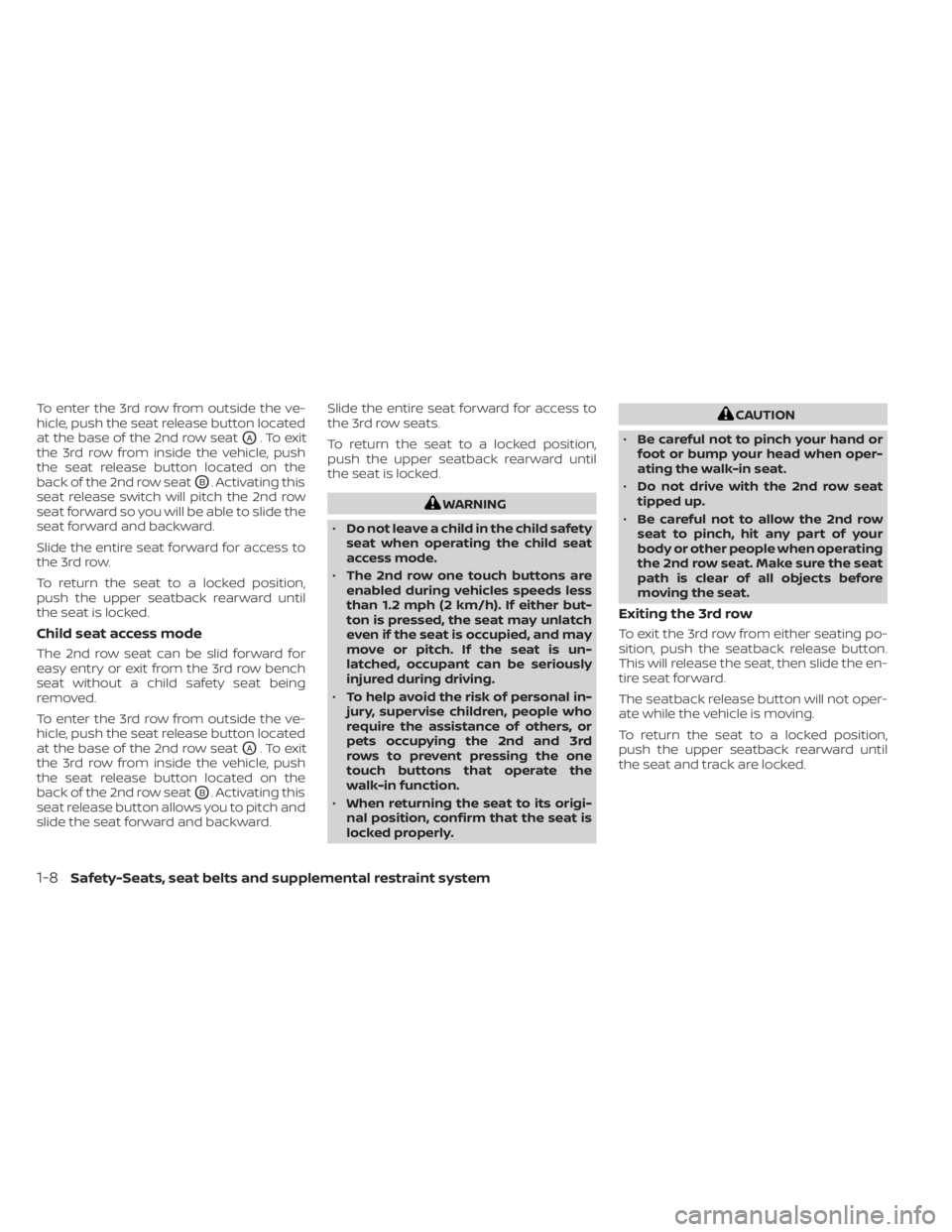
To enter the 3rd row from outside the ve-
hicle, push the seat release button located
at the base of the 2nd row seat
OA. To exit
the 3rd row from inside the vehicle, push
the seat release button located on the
back of the 2nd row seat
OB. Activating this
seat release switch will pitch the 2nd row
seat forward so you will be able to slide the
seat forward and backward.
Slide the entire seat forward for access to
the 3rd row.
To return the seat to a locked position,
push the upper seatback rearward until
the seat is locked.
Child seat access mode
The 2nd row seat can be slid forward for
easy entry or exit from the 3rd row bench
seat without a child safety seat being
removed.
To enter the 3rd row from outside the ve-
hicle, push the seat release button located
at the base of the 2nd row seat
OA. To exit
the 3rd row from inside the vehicle, push
the seat release button located on the
back of the 2nd row seat
OB. Activating this
seat release button allows you to pitch and
slide the seat forward and backward. Slide the entire seat forward for access to
the 3rd row seats.
To return the seat to a locked position,
push the upper seatback rearward until
the seat is locked.
WARNING
• Do not leave a child in the child safety
seat when operating the child seat
access mode.
• The 2nd row one touch buttons are
enabled during vehicles speeds less
than 1.2 mph (2 km/h). If either but-
ton is pressed, the seat may unlatch
even if the seat is occupied, and may
move or pitch. If the seat is un-
latched, occupant can be seriously
injured during driving.
• To help avoid the risk of personal in-
jury, supervise children, people who
require the assistance of others, or
pets occupying the 2nd and 3rd
rows to prevent pressing the one
touch buttons that operate the
walk-in function.
• When returning the seat to its origi-
nal position, confirm that the seat is
locked properly.
CAUTION
• Be careful not to pinch your hand or
foot or bump your head when oper-
ating the walk-in seat.
• Do not drive with the 2nd row seat
tipped up.
• Be careful not to allow the 2nd row
seat to pinch, hit any part of your
body or other people when operating
the 2nd row seat. Make sure the seat
path is clear of all objects before
moving the seat.
Exiting the 3rd row
To exit the 3rd row from either seating po-
sition, push the seatback release button.
This will release the seat, then slide the en-
tire seat forward.
The seatback release button will not oper-
ate while the vehicle is moving.
To return the seat to a locked position,
push the upper seatback rearward until
the seat and track are locked.
1-8Safety-Seats, seat belts and supplemental restraint system
Page 49 of 665
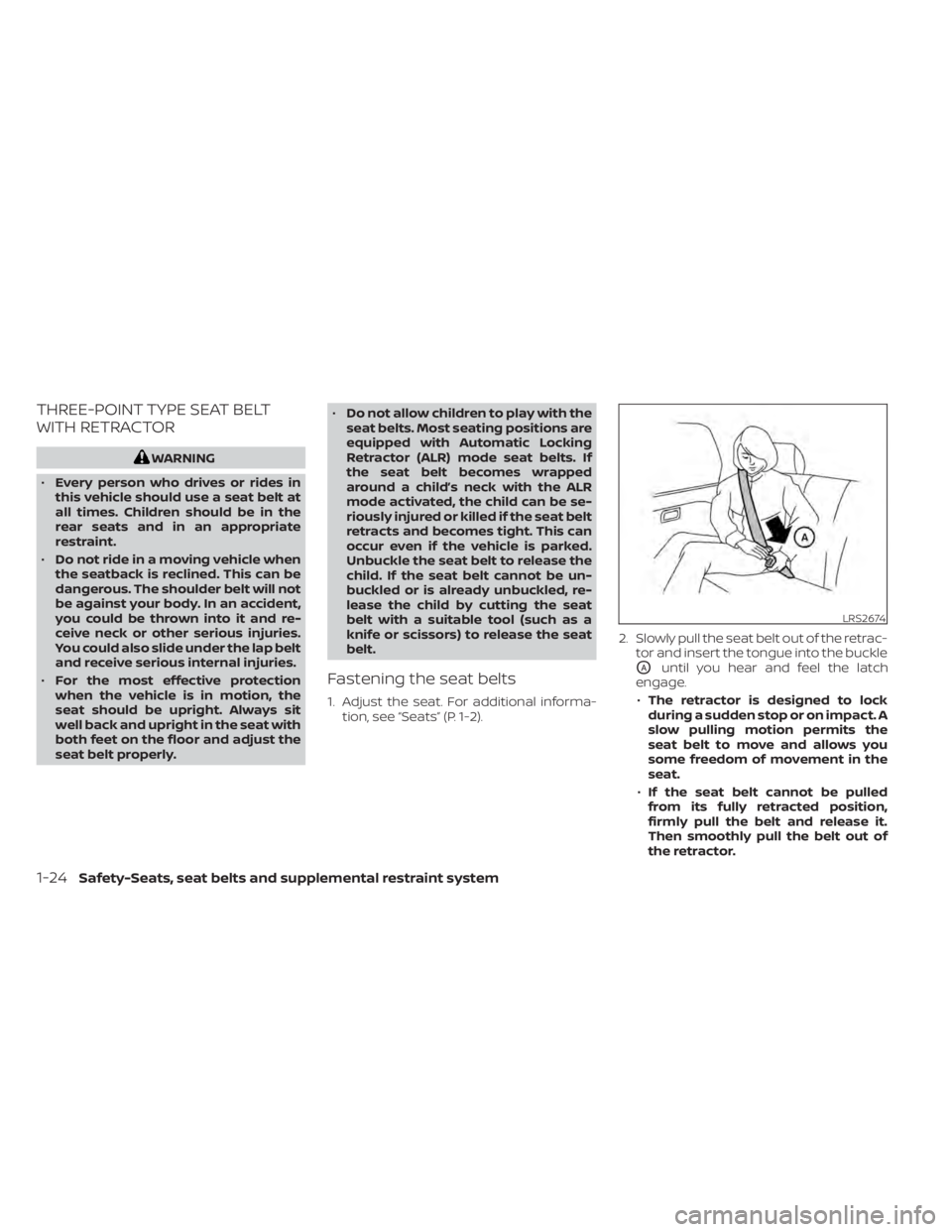
THREE-POINT TYPE SEAT BELT
WITH RETRACTOR
WARNING
• Every person who drives or rides in
this vehicle should use a seat belt at
all times. Children should be in the
rear seats and in an appropriate
restraint.
• Do not ride in a moving vehicle when
the seatback is reclined. This can be
dangerous. The shoulder belt will not
be against your body. In an accident,
you could be thrown into it and re-
ceive neck or other serious injuries.
You could also slide under the lap belt
and receive serious internal injuries.
• For the most effective protection
when the vehicle is in motion, the
seat should be upright. Always sit
well back and upright in the seat with
both feet on the floor and adjust the
seat belt properly. •
Do not allow children to play with the
seat belts. Most seating positions are
equipped with Automatic Locking
Retractor (ALR) mode seat belts. If
the seat belt becomes wrapped
around a child’s neck with the ALR
mode activated, the child can be se-
riously injured or killed if the seat belt
retracts and becomes tight. This can
occur even if the vehicle is parked.
Unbuckle the seat belt to release the
child. If the seat belt cannot be un-
buckled or is already unbuckled, re-
lease the child by cutting the seat
belt with a suitable tool (such as a
knife or scissors) to release the seat
belt.
Fastening the seat belts
1. Adjust the seat. For additional informa- tion, see “Seats” (P. 1-2). 2. Slowly pull the seat belt out of the retrac-
tor and insert the tongue into the buckle
OAuntil you hear and feel the latch
engage.
• The retractor is designed to lock
during a sudden stop or on impact. A
slow pulling motion permits the
seat belt to move and allows you
some freedom of movement in the
seat.
• If the seat belt cannot be pulled
from its fully retracted position,
firmly pull the belt and release it.
Then smoothly pull the belt out of
the retractor.
LRS2674
1-24Safety-Seats, seat belts and supplemental restraint system
Page 50 of 665
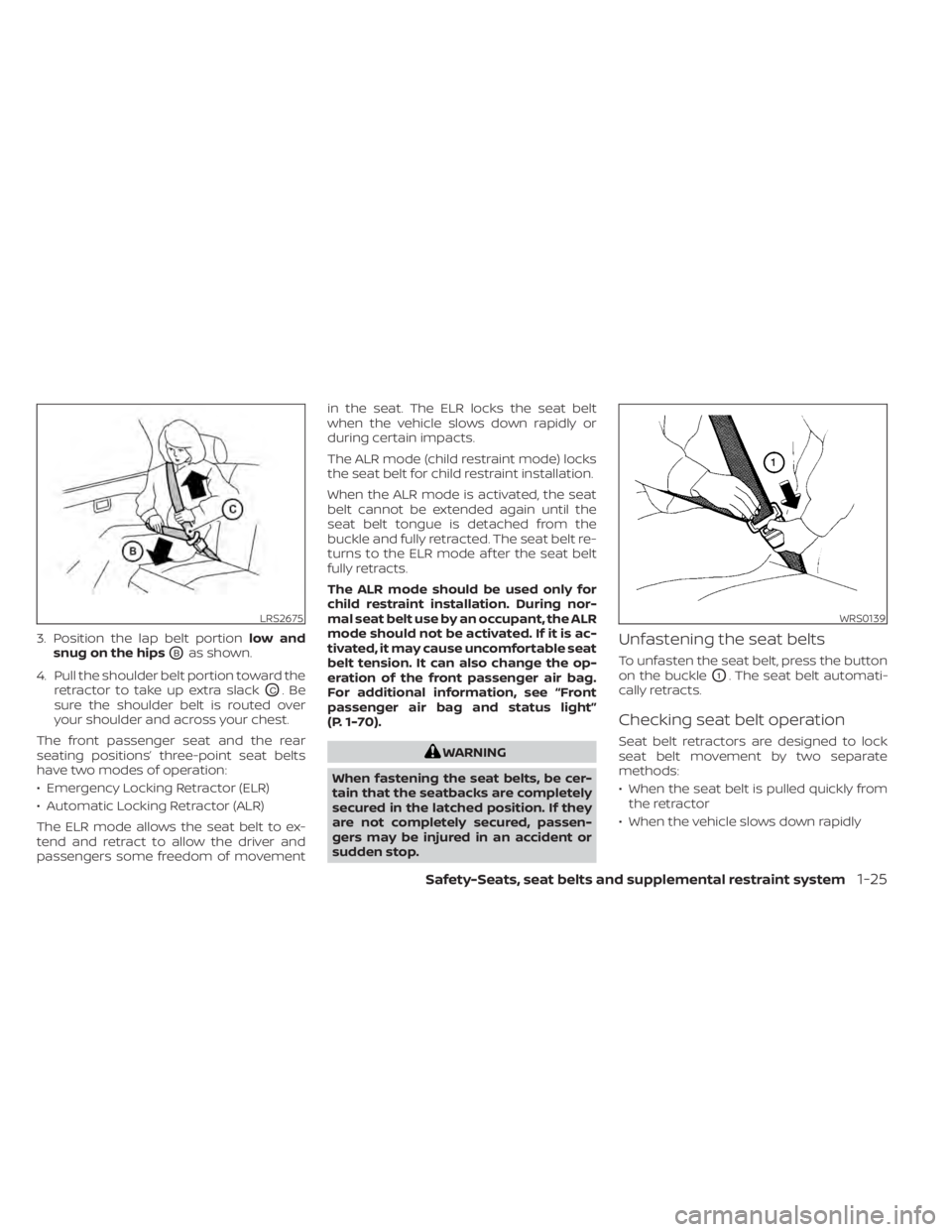
3. Position the lap belt portionlow and
snug on the hips
OBas shown.
4. Pull the shoulder belt portion toward the retractor to take up extra slack
OC.Be
sure the shoulder belt is routed over
your shoulder and across your chest.
The front passenger seat and the rear
seating positions’ three-point seat belts
have two modes of operation:
• Emergency Locking Retractor (ELR)
• Automatic Locking Retractor (ALR)
The ELR mode allows the seat belt to ex-
tend and retract to allow the driver and
passengers some freedom of movement in the seat. The ELR locks the seat belt
when the vehicle slows down rapidly or
during certain impacts.
The ALR mode (child restraint mode) locks
the seat belt for child restraint installation.
When the ALR mode is activated, the seat
belt cannot be extended again until the
seat belt tongue is detached from the
buckle and fully retracted. The seat belt re-
turns to the ELR mode af ter the seat belt
fully retracts.
The ALR mode should be used only for
child restraint installation. During nor-
mal seat belt use by an occupant, the ALR
mode should not be activated. If it is ac-
tivated, it may cause uncomfortable seat
belt tension. It can also change the op-
eration of the front passenger air bag.
For additional information, see “Front
passenger air bag and status light”
(P. 1-70).
WARNING
When fastening the seat belts, be cer-
tain that the seatbacks are completely
secured in the latched position. If they
are not completely secured, passen-
gers may be injured in an accident or
sudden stop.
Unfastening the seat belts
To unfasten the seat belt, press the button
on the buckle
O1. The seat belt automati-
cally retracts.
Checking seat belt operation
Seat belt retractors are designed to lock
seat belt movement by two separate
methods:
• When the seat belt is pulled quickly from the retractor
• When the vehicle slows down rapidly
LRS2675WRS0139
Safety-Seats, seat belts and supplemental restraint system1-25
Page 51 of 665
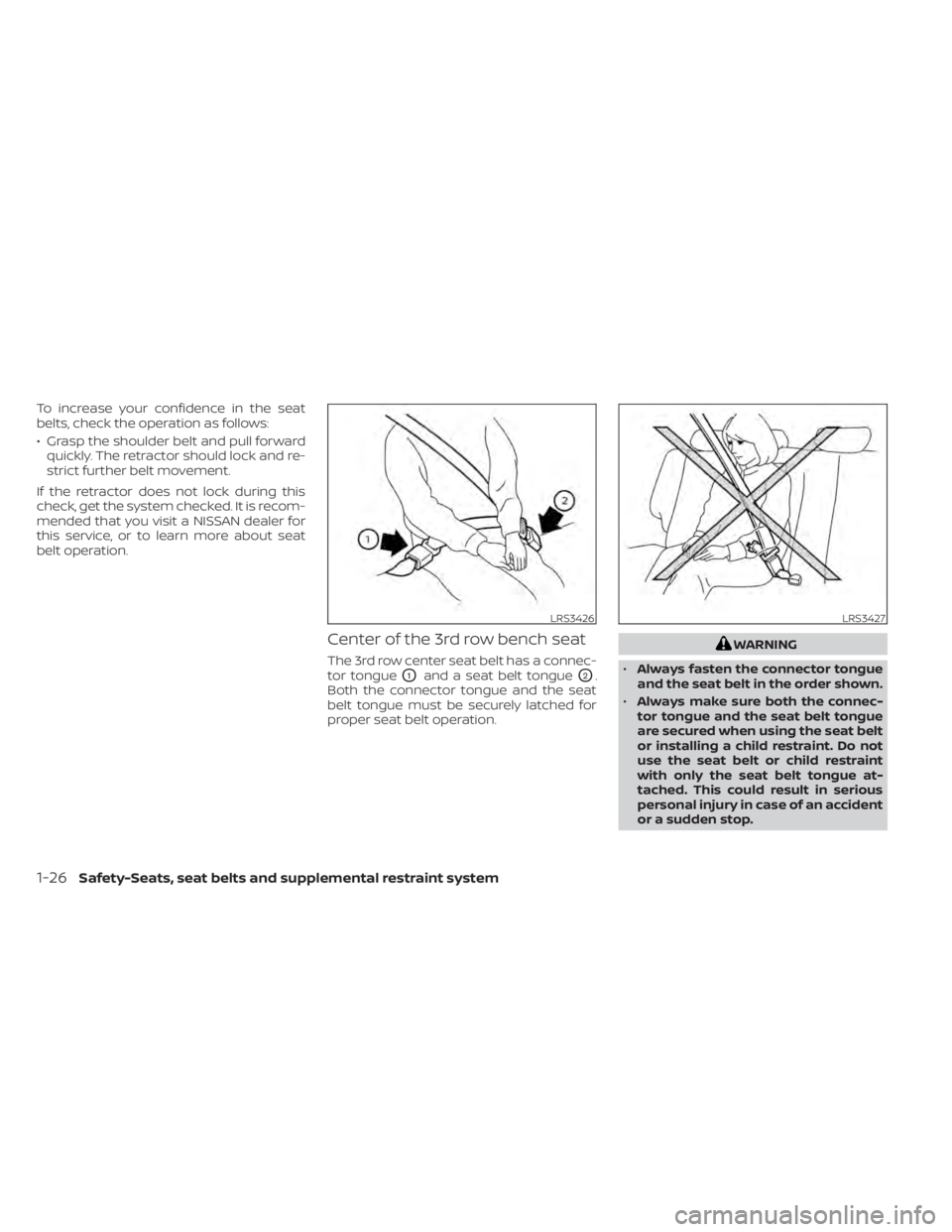
To increase your confidence in the seat
belts, check the operation as follows:
• Grasp the shoulder belt and pull forwardquickly. The retractor should lock and re-
strict further belt movement.
If the retractor does not lock during this
check, get the system checked. It is recom-
mended that you visit a NISSAN dealer for
this service, or to learn more about seat
belt operation.
Center of the 3rd row bench seat
The 3rd row center seat belt has a connec-
tor tongue
O1and a seat belt tongueO2.
Both the connector tongue and the seat
belt tongue must be securely latched for
proper seat belt operation.
WARNING
• Always fasten the connector tongue
and the seat belt in the order shown.
• Always make sure both the connec-
tor tongue and the seat belt tongue
are secured when using the seat belt
or installing a child restraint. Do not
use the seat belt or child restraint
with only the seat belt tongue at-
tached. This could result in serious
personal injury in case of an accident
or a sudden stop.
LRS3426LRS3427
1-26Safety-Seats, seat belts and supplemental restraint system
Page 54 of 665
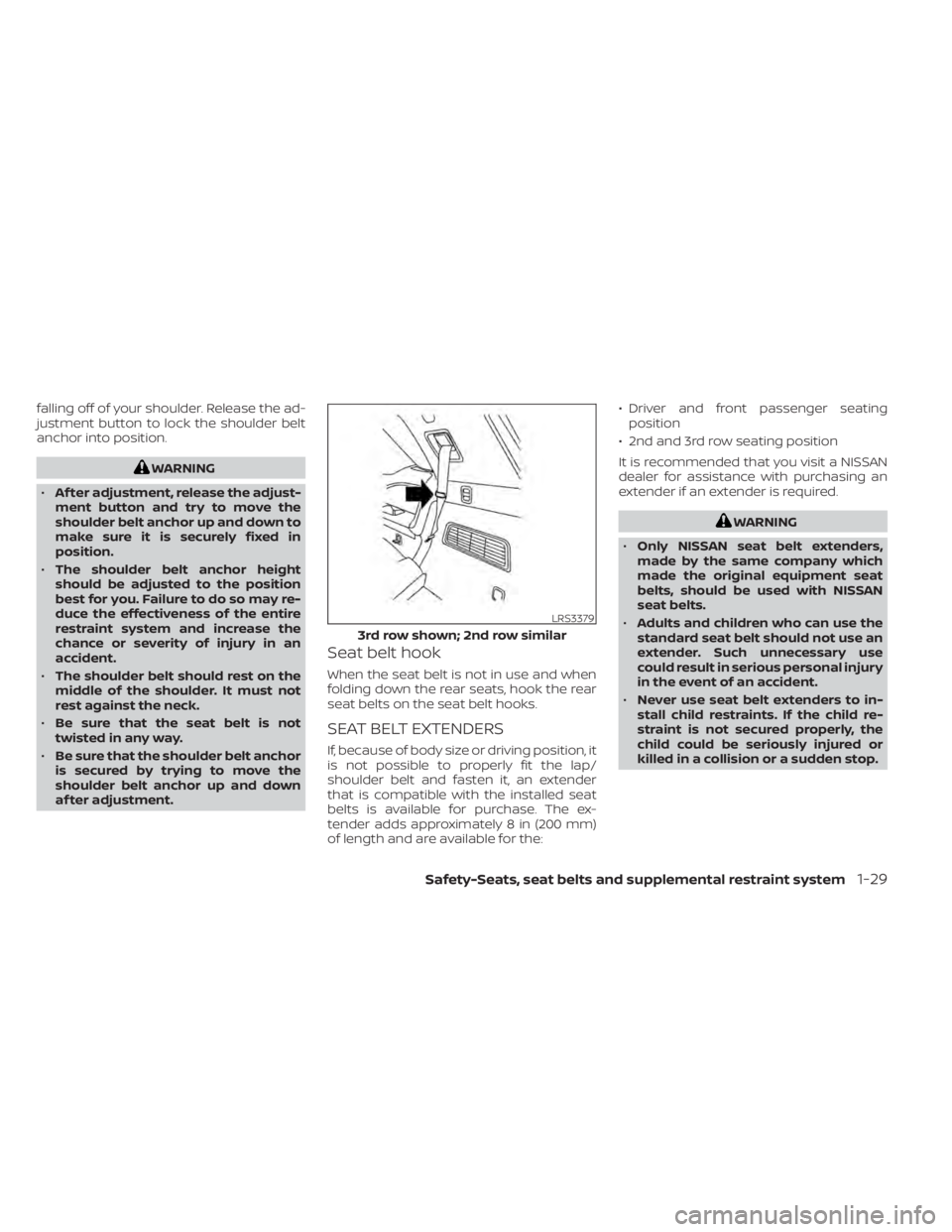
falling off of your shoulder. Release the ad-
justment button to lock the shoulder belt
anchor into position.
WARNING
• Af ter adjustment, release the adjust-
ment button and try to move the
shoulder belt anchor up and down to
make sure it is securely fixed in
position.
• The shoulder belt anchor height
should be adjusted to the position
best for you. Failure to do so may re-
duce the effectiveness of the entire
restraint system and increase the
chance or severity of injury in an
accident.
• The shoulder belt should rest on the
middle of the shoulder. It must not
rest against the neck.
• Be sure that the seat belt is not
twisted in any way.
• Be sure that the shoulder belt anchor
is secured by trying to move the
shoulder belt anchor up and down
af ter adjustment.
Seat belt hook
When the seat belt is not in use and when
folding down the rear seats, hook the rear
seat belts on the seat belt hooks.
SEAT BELT EXTENDERS
If, because of body size or driving position, it
is not possible to properly fit the lap/
shoulder belt and fasten it, an extender
that is compatible with the installed seat
belts is available for purchase. The ex-
tender adds approximately 8 in (200 mm)
of length and are available for the: • Driver and front passenger seating
position
• 2nd and 3rd row seating position
It is recommended that you visit a NISSAN
dealer for assistance with purchasing an
extender if an extender is required.
WARNING
• Only NISSAN seat belt extenders,
made by the same company which
made the original equipment seat
belts, should be used with NISSAN
seat belts.
• Adults and children who can use the
standard seat belt should not use an
extender. Such unnecessary use
could result in serious personal injury
in the event of an accident.
• Never use seat belt extenders to in-
stall child restraints. If the child re-
straint is not secured properly, the
child could be seriously injured or
killed in a collision or a sudden stop.
LRS3379
3rd row shown; 2nd row similar
Safety-Seats, seat belts and supplemental restraint system1-29